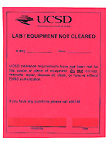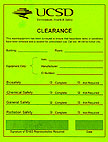Guidelines for Non-laboratory Personnel Working in Laboratories
See guidelines for non-laboratory personnel who perform work in UC San Diego research facilities.
Hazard and caution signs
Some UC San Diego labs do theoretical research and use only electronics and computers in their work.
Signs identify labs where hazardous chemicals, infectious agents, radioactive materials, or equipment such as high energy lasers and powerful magnets are present. These materials and equipment are generally controlled and contained, and their hazards minimized.
- Do not enter an area or laboratory with a sign that warns against unauthorized entry or says Keep Out, unless specifically directed to do so by the principal investigator (PI) who controls the space or the Department Safety Coordinator or Department Safety Officer.
- Read Hazard and Caution Signs for a description of signs you may see.
Work in occupied spaces
Sensitive experiments can be destroyed by exposure to light, changes in temperature, or contamination from the outside environment.
- Coordinate your work with the Area Safety Coordinator or lab manager by doing the following:
- Explain the work that will be performed, especially any actions that could affect lab operations.
- Give advanced warning for the following possibilities:
- Utility shut-offs, so experiments and sensitive materials can be protected with alternative power sources
- Work with equipment that may generate heat or sparks, so flammable materials can be safely stored away from the work area
- Wait for lab personnel to clear the work area of hazardous materials and contamination before beginning work.
- Do not move lab equipment or chemicals without direct assistance or approval from lab personnel.
- Contact your supervisor and wait for instructions if there is no one in the lab to assist you when laboratory equipment or chemicals need to be moved. Do not start work until specifically cleared to do so.
- Take these steps to protect yourself from hazards in laboratories:
- Do not eat, drink, or apply cosmetics in a lab.
- Wash your hands after leaving a lab.
- Wear the following personal protection equipment as necessary:
- Gloves
- Single-use surgical type Nitrile gloves are recommended to protect against potential contamination
- Leather gloves guard against possible puncture or lacerations
- Eye protection (many labs require safety glasses to be worn at all times)
- Protective clothing, such as a lab coat or coveralls
- Gloves
- Locate the nearest fire extinguisher, or keep an ABC extinguisher by your work area. (An ABC extinguisher is located near the exit door of most UC San Diego laboratories.)
- Follow these guidelines for work inside a fume hood:
- Do not remove or disturb equipment or materials yourself.
- Wait for laboratory staff to remove equipment and supplies from the fume hood, and decontaminate the inside surface.
- The Department Safety Coordinator or Department Safety Officer will determine whether the fume hood has been used for work with perchloric acid before ANY work can be done.
- Wear heavy rubber gloves (or other impervious material) and safety goggles for work inside a fume hood. Disposable coveralls are recommended. Immediately wash or dispose of the gloves and coveralls after use.
- Be alert for the possibility of asbestos-containing materials and lead-based paint.
- The hard gray panels on the inside of many older hoods are made of transite, which contains asbestos. Removal of transite or other asbestos must be coordinated with Environment, Health & Safety (EH&S).
- Read Asbestos Action Plan for UC San Diego Project Managers and Lead-Based Paint Action Plan for UC San Diego Project Managers for more information.
- Do not work near waste containers or work surfaces labeled with biohazard, radioactive, carcinogen, or other specific warning signs.
- See a discussion of hazard and caution signs used in laboratories.
Work in vacated labs

Red clearance card indicates clearance procedures are in progress

Green clearance card is posted by EH&S when a facility is cleared of known hazards
When a research group leaves a laboratory, a clearance survey is performed to ensure hazards are not left behind.
- EH&S posts a red tag when researchers vacate a lab, to indicate clearance procedures have begun in the facility. A red tag will still allow custodians to enter and empty regular trash.
- EH&S posts a green clearance tag after hazards are removed, indicating the facility is safe for non-laboratory personnel to enter and begin work.
- Contact your supervisor if hidden hazards (such as broken glass, needles, or small amounts of mercury metal in drain traps) are discovered after work begins. Do not resume work until the hazard has been corrected.
Protect building occupants
In many areas, maintenance, service, or repair actions can significantly impact the work and safety of people elsewhere in the building.
Take these steps to protect building occupants:
- Never turn off building alarms without first coordinating with your supervisor and EH&S, (858) 534-3660.
- Notify EH&S, (858) 534-3660, in advance if your work requires turning off a blower, de-energizing an electrical circuit, or disrupting any utilities. Unanticipated interruptions may expose people to hazardous situations.
- Avoid using hazardous materials, strong-smelling materials, or combustion-driven equipment inside the building or near air intakes. Air intakes are typically located near loading docks.
- Do not pour hazardous materials down the drain or dump them anywhere on campus.
- Dispose of hazardous waste properly. Read How to Request a Hazardous Waste Collection.
- Keep hallways and stairways clear to allow emergency exit.
- Do not block extinguishers, fire alarm pull stations, electrical panels, eye washes, or emergency showers.
- Expect extra precautions for work in "clean areas." Clean areas are special facilities where animals, patients, or equipment are highly susceptible to everyday germs, dust, and dirt.
- Expect to be asked to wear coveralls, a gown, a mask, or other protective gear to protect patients or research from possible contamination.
Prepare for emergencies
-
Follow instructions on the UC San Diego Emergency Guide when an emergency occurs. Basic procedures are described below.
- Fire:
- Small fire in your area:
- Pull the fire alarm, even if you think you can successfully extinguish the fire. Use a fire extinguisher if:
- You have been trained
- You have a clear exit path behind you
- Pull the fire alarm, even if you think you can successfully extinguish the fire. Use a fire extinguisher if:
- Large fire:
- Evacuate, closing the door behind you.
- Pull the fire alarm.
- Call 9-1-1.
- Wait outside the building in a safe area for emergency personnel to respond.
- If a building alarm sounds:
- Turn off your equipment.
- Evacuate the building and wait for authorization to re-enter.
- Small fire in your area:
- Spills of lab materials:
- Notify everyone to evacuate the area.
- Close the door behind you.
- Follow instructions on the UC San Diego Emergency Guide.
- Injury:
- Call 9-1-1 to summon medical assistance.
- Follow instructions on the UC San Diego Emergency Guide.
- Get emergency care at one of the following UC San Diego locations:
- Main campus: Thornton Hospital
- UC San Diego Medical Center in Hillcrest: Medical Center Emergency Medicine